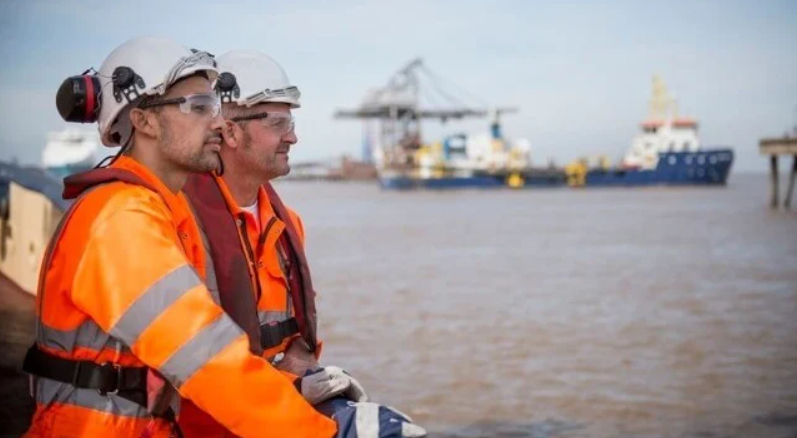Learn about the three most important ports of Sri Lanka eBlue Economy that highlight them
Colombo port
Since 1918, the Port of Colombo had been administered by the Colombo Port Commission, a Government Department which was made responsible for the supply and maintenance of cargo-handling equipment and other infrastructure, pilotage services, docking, and slipping.
The government had funded all its activities. Stevedoring and shore handling activities were in the hands of several private Wharfage Companies. In 1958, the Port Cargo Corporation was set up to take over these activities performed by a multiplicity of operators.

The Port Tally and Protective Services Corporation was formed in 1967 in order to perform on-board tallying and watchmen services on behalf of Agents.
The Sri Lanka Ports Authority was constituted under the provisions of the Sri Lanka Ports Authority Act, No. 15 of 1979 (subsequently amended by Act No. 7 of 1984 and Act No. 35 of 1984) on the 1st of August 1979, effecting the merger of the Colombo Port Commission Department and the two existing statutory Corporations.

This resulted in a unified organization with a streamlined structure. The Ports Authority does not receive financial allocations from the government but operates on its own revenue and resources.
The biggest seaport of Sri Lanka, Colombo port is situated on the country’s southwestern coastline at the mouth of the river Kelani Ganga. It ranks among the top 25 ports in the world and is one of the busiest container ports with an annual handling capacity of 7 million TEUs.
More than 60% of the island nation’s international maritime trade passes through this facility. A major Indian Ocean port, it boasts one of the world’s most expansive artificial harbours. Its history goes back to 2000 years when it was a major trading post used by the Romans, Arabs, and Chinese merchants.

An important transshipment port of South Asia, Colombo handles containers and bulk cargoes originating from and destined for major European countries, East Asia, Africa, and the Persian Gulf.
The port attained an all-time high container throughput of 7.25 million TEU and registered a 5.84% growth in 2021 compared to 2020 figures, as per the data released by Sri Lanka Port Authority. It also saw 3675 ship arrivals including 3180 container ships in 2021.

Colombo port was modernized and refurbished in 2008 and dredged to a depth of 15 m for accommodating vessels with a deeper draft. The port covers 1200 acres and has 51 berths for handling diverse cargoes except for hazardous substances and perishable goods. It has more than 25 warehouses, a 200 sq m cool room, and four major terminal facilities.

Hambantota port
Hambantota port is also known as the Magampura Mahinda Rajapaksha port and is situated in the southern part of Sri Lanka. It is close to the Asian and European maritime trade routes, the Suez Canal, and Malacca Strait.

More than 39,000 ships and 5000 oil tankers pass through these routes which save freight costs and reduces sailing time by three days. It is also the country’s most diverse deepwater facility, constructed in 2008 with Chinese financial aid and given to China on a 99-year lease.
The construction of Hambantota Port is one of the major development projects that had been undertaken by Sri Lanka ports Authority. This port development work is scheduled to implement in phases. Phase I development has already been completed while phase II development is in progress.

This port is located in very close proximity to the major international east-west shipping route and is well-positioned at a strategic location on a maritime gateway to India. A large number of ships pass Sri Lanka daily along this shipping route which creates good business opportunities for providing services like supply of fuel, water, and crew change in addition to the usual port operations.
From a domestic trade perspective, it is better positioned with a direct roadway connection to the southern, central and eastern areas of the island and serves the Southern half of the island by linking with the Central and Eastern provinces by roads.
The harbor area is basically protected by 312m and 988m long two breakwaters. An access channel of 210 m width and 17m depth is provided with a turning circle of 600m diameter and 17m deep to facilitate vessels up to 100,000 DWT.
A 610 m general cargo berth and two 300 m oil jetties with a depth of 16 m were built in the first phase along with a bunkering facility and a tank farm containing 14 tanks with a storage capacity of 80,000m3. The port also has a fully-automated RoRo terminal with inbuilt ramps for handling inbound and transshipment vehicles.
A multipurpose terminal, a container terminal, a dockyard, fertilizer factory, warehouse facilities, and transshipment centers are being constructed as part of the second phase. Once completed the port will handle 20,000,000 TEU every year. A 60-hectare yard area next to the quay wall is almost complete and is said to be operational from 2023.

Galle Harbour
Galle Harbour is a natural harbour, located in Galle, south-western coast of Sri Lanka. Currently Galle port serves as one of the most active regional ports in the country and it is also the only Sri Lankan port that provides facilities for pleasure yachts. International yacht societies have recognized Galle harbour as one of the world’s best attractions for yachting.

Galle harbour was a major harbour in the country, which was in use even during the pre-Christian times but gained importance after the 12th century.[2] By the 14th century, Galle harbour was the most important harbour in Sri Lanka and retained its importance until 1873 when an artificial harbour was built in Colombo.
After the construction of Galle Fort in the 17th century, Galle port was a major port in the Indian Ocean for more than 200 years, which was an important anchorage for boats and ships traveling between Europe and Asia.
When the British colonial government constructed breakwaters in the Colombo Harbour in the late 19th century, much international marine traffic shifted to Colombo from Galle.
Thereafter Galle port became a secondary port of the country, though it still handles some ships and boats.
Port of Galle is Sri Lanka’s oldest port, situated on the South-Western coast of Sri Lanka. Galle has a strong position in services to main line vessels on the East-West trade route, due to its convenient location near the maritime trade lane. However, the port has limited depth and is not able to handle large vessels.
The Port of Galle has been planned to develop as a regional port utilizing its infrastructure and strategic location for commercial and tourism aspects.
Considering the importance of attracting aforesaid opportunities and highly dilapidated infrastructure in the Port, Galle Port Development Project (GPDP) has been planned to enhance its infrastructure and the safe water area. Under the purview of GPDP, plans have been made to construct a breakwater protecting the entire gulf of Galle.
The proposed development project expects to avail fully-fledged facilities in the gulf of Galle to make possible the berthing of super yachts, small boats, passenger cruises, water sports, and many more activities. The goal of this development project is to ensure that everything is within your reach.














